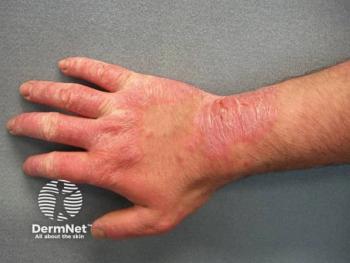
Guselkumab Effectively Inhibits Joint Structural Damage in Active PsA
Key Takeaways
- Guselkumab significantly inhibits joint structural damage progression in PsA, as shown in the phase 3b APEX study.
- The study demonstrated guselkumab's efficacy in reducing PsA symptoms, with higher ACR20 and ACR50 response rates than placebo.
Data presented at EULAR 2025 showcased Tremfya's efficacy as the only IL-23 inhibitor to demonstrate inhibition of this nature in psoriatic arthritis.
Presented at the ongoing European Alliance of Associations for Rheumatology 2025 Congress June 11-14, 2025, in Barcelona, Spain, the phase 3b APEX study (
The randomized, double-blinded, placebo-controlled study included a cohort of biologic naïve individuals with PsA who had presented with a history of inadequate response to csDMARDs, apremilast (Otezla; Amgen), and/or NSAIDs. Participants were treated with either guselkumab or placebo for a 24-week period. The study also included a 12-week follow-up period.
From baseline to week 24 of the active treatment phase, patients treated with guselkumab every 4 weeks demonstrated an average change in modified van der Heijde-Sharp (vdH-S) score of 0.55 from baseline. Meanwhile, patients treated with guselkumab every 8 weeks demonstrated an average change in vdH-S score of 0.54 from baseline.
In the placebo treatment group, participants dosed every 8 weeks recorded an average 1.35 change in vdH-S from baseline.
In addition, guselkumab demonstrated significant improvements in signs and symptoms of PsA versus placebo. Higher proportions of guselkumab-treated patients recorded achieved American College of Rheumatology (ACR) response, or ACR20, at week 24 (67% for every 4 weeks; 68% for every 8 weeks) versus 47% in the placebo group.
At week 24, more than twice as many patients treated with guselkumab reached ACR50 compared to placebo. Additionally, significantly more guselkumab-treated patients achieved clear or almost clear skin than those on placebo.
No new safety signals were reported.
"In psoriatic arthritis, joint damage can begin early and progress quickly if left untreated, significantly impacting a patient’s ability to move, work and maintain independence," Philip Mease, MD, director of rheumatology research at the Swedish Medical Center and study investigator, said in a news release.1 "The results of the APEX study are promising as the data show guselkumab to be the only IL-23 inhibitor in its class that has inhibited the progression of structural damage in patients, providing new clinical insights for the psoriatic community and underscoring the need for safe, effective options that address the full burden of disease."
Participants were also invited to participate in the APEX long-term extension trial, which involves an additional 2-year active treatment period and a final safety follow-up.
"With these results from the APEX study, Tremfya has set a new bar for joint preservation as the only IL-23 inhibitor proven to significantly inhibit structural damage in active psoriatic arthritis," Terence Rooney, vice president and rheumatology disease area leader at Johnson & Johnson Innovative Medicine, said.1 "The efficacy and safety profile of Tremfya offers psoriatic health care providers and patients an innovative option for disease control."
References
- New data show TREMFYA (guselkumab) is the only IL-23 inhibitor proven to significantly inhibit progression of joint structural damage in active psoriatic arthritis. News release. Johnson & Johnson. June 11, 2025. Accessed June 11, 2025.
https://www.jnj.com/media-center/press-releases/new-data-show-tremfya-guselkumab-is-the-only-il-23-inhibitor-proven-to-significantly-inhibit-progression-of-joint-structural-damage-in-active-psoriatic-arthritis - Janssen Research & Development, LLC. A study of guselkumab in participants with active psoriatic arthritis (APEX). ClinicalTrials.gov. NCT04882098. Updated May 23, 2025. Accessed June 11, 2025.
https://clinicaltrials.gov/study/NCT04882098
Newsletter
Like what you’re reading? Subscribe to Dermatology Times for weekly updates on therapies, innovations, and real-world practice tips.



















